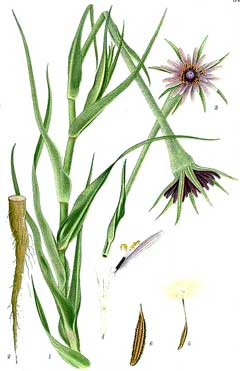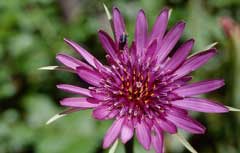 |
|
commons.wikimedia.org/wiki/File:549_Tragopogon_porrifolius.jpg |
 |
| commons.wikimedia.org/wiki/User:Entomolo |
Translate this page:
Summary
Tragopogon porrifolius, commonly known as salsify or oyster plant, is primarily grown for its edible root and sometimes young shoots, but it also offers several non-edible uses that make it valuable in ecological and traditional systems.
One of its key features is its deep taproot, which can help break up compacted soils and improve soil structure, particularly in degraded or low-fertility areas. As the plant matures and dies back, the decaying root channels allow for improved water infiltration and aeration, contributing to soil health.
Tragopogon porrifolius is also appreciated for its value to pollinators, especially bees. Its large, purple, daisy-like flowers produce nectar and pollen, and they bloom relatively early, offering an important food source when few other plants may be flowering. Additionally, the plant’s large seed heads, which resemble those of dandelions, provide structural habitat or nesting materials for invertebrates and small wildlife.
Although not well-studied in traditional herbal medicine, parts of the plant have been used for diuretic, digestive, and detoxifying purposes. While primarily anecdotal, these uses reflect its long-standing presence in folk remedies across Europe.
Its aesthetic appeal should also be mentioned—its striking flowers and large, globe-like seed heads lend themselves to naturalistic garden design, cut flower arrangements, or dried ornamental displays. Though often grown for food, salsify can fit well into permaculture gardens or pollinator-supporting plantings, adding biodiversity and visual interest while quietly working belowground to improve soil over time.
Physical Characteristics

 Tragopogon porrifolius is a BIENNIAL growing to 0.6 m (2ft).
Tragopogon porrifolius is a BIENNIAL growing to 0.6 m (2ft).
See above for USDA hardiness. It is hardy to UK zone 5 and is not frost tender. It is in flower from June to August, and the seeds ripen from July to September. The species is hermaphrodite (has both male and female organs) and is pollinated by Insects.
Suitable for: light (sandy), medium (loamy) and heavy (clay) soils, prefers well-drained soil and can grow in heavy clay soil. Suitable pH: mildly acid, neutral and basic (mildly alkaline) soils. It cannot grow in the shade. It prefers moist soil. The plant can tolerates strong winds but not maritime exposure.
UK Hardiness Map
US Hardiness Map
Synonyms
T. sinuatus. Avé Lall.
Plant Habitats
Cultivated Beds;
Edible Uses
Edible Parts: Flowers Leaves Root Seed Shoots Stem
Edible Uses: Gum
Root - raw or cooked[2, 5, 27, 33, 37, 89]. The young root can be grated in salads[12], older roots are best cooked[183]. The flavour is mild and sweet, and is said to resemble oysters[183, K]. The roots are harvested as required from October until early spring, or can be harvested in late autumn and stored until required[4]. Young shoots - raw or cooked[2, 12, 27, 33, 37, 52, 183]. The new growth is used in spring. A sweet taste[200]. Flowering shoots - raw or cooked[200]. Used like asparagus. Flowers - raw. Added to salads[183]. The sprouted seeds can be added to salads or sandwiches[183]. The root latex is used as a chewing gum[61, 105, 161, 183].
References More on Edible Uses
Medicinal Uses
Plants For A Future can not take any responsibility for any adverse effects from the use of plants. Always seek advice from a professional before using a plant medicinally.
Antibilious Aperient Deobstruent Diuretic
Salsify is a cleansing food with a beneficial effect upon the liver and gallbladder[254]. The root is antibilious, slightly aperient, deobstruent and diuretic[4, 21]. It is specific in the treatment of obstructions of the gall bladder and jaundice[240] and is also used in the treatment of arteriosclerosis and high blood pressure[254].
References More on Medicinal Uses
The Bookshop: Edible Plant Books
Our Latest books on Perennial Plants For Food Forests and Permaculture Gardens in paperback or digital formats.

Edible Tropical Plants
Food Forest Plants for Hotter Conditions: 250+ Plants For Tropical Food Forests & Permaculture Gardens.
More

Edible Temperate Plants
Plants for Your Food Forest: 500 Plants for Temperate Food Forests & Permaculture Gardens.
More

More Books
PFAF have eight books available in paperback and digital formats. Browse the shop for more information.
Shop Now
Other Uses
Gum
One of its key features is its deep taproot, which can help break up compacted soils and improve soil structure, particularly in degraded or low-fertility areas. As the plant matures and dies back, the decaying root channels allow for improved water infiltration and aeration, contributing to soil health.
Tragopogon porrifolius is also appreciated for its value to pollinators, especially bees. Its large, purple, daisy-like flowers produce nectar and pollen, and they bloom relatively early, offering an important food source when few other plants may be flowering. Additionally, the plant’s large seed heads, which resemble those of dandelions, provide structural habitat or nesting materials for invertebrates and small wildlife.
Its aesthetic appeal should also be mentioned—its flowers and large, globe-like seed heads are striking, lending themselves to naturalistic garden design, cut flower arrangements, or dried ornamental displays. Though often grown for food, salsify can fit well into permaculture gardens or pollinator-supporting plantings, adding biodiversity and visual interest while quietly working belowground to improve soil over time.
Special Uses
References More on Other Uses
Cultivation details
Succeeds in ordinary garden soils, including heavy clays[4, 200]. Plants do not grow well in stony soils[4]. Prefers an open situation[37] and a cool moist root run[14, 20]. Salsify is occasionally cultivated in the garden for its edible root[2, 89], there are some named varieties[183]. Grows well with mustard[20].
References Carbon Farming Information and Carbon Sequestration Information
Temperature Converter
Type a value in the Celsius field to convert the value to Fahrenheit:
Fahrenheit:
The PFAF Bookshop
Plants For A Future have a number of books available in paperback and digital form. Book titles include Edible Plants, Edible Perennials, Edible Trees,Edible Shrubs, Woodland Gardening, and Temperate Food Forest Plants. Our new book is Food Forest Plants For Hotter Conditions (Tropical and Sub-Tropical).
Shop Now
Plant Propagation
Seed - sow in situ as early in the year as possible, in March if weather conditions permit[4]. Seed sowings often fail unless the soil is kept moist until the seedlings are growing well[4].
Other Names
If available other names are mentioned here
Native Range
TEMPERATE ASIA: Cyprus, Egypt (Sinai), Israel, Jordan, Lebanon, Syria, Turkey (west), Armenia, Azerbaijan EUROPE: Bulgaria, Bosnia and Herzegovina, Greece (incl. Crete), Croatia, Italy (incl. Sardinia, Sicily), North Macedonia, Montenegro, Romania, Slovenia, Spain (incl. Baleares), France (incl. Corsica) AFRICA: Algeria (north), Libya (north), Morocco, Tunisia
Weed Potential
Right plant wrong place. We are currently updating this section.
Please note that a plant may be invasive in one area but may not in your area so it's worth checking.
Conservation Status
IUCN Red List of Threatened Plants Status :

Growth: S = slow M = medium F = fast. Soil: L = light (sandy) M = medium H = heavy (clay). pH: A = acid N = neutral B = basic (alkaline). Shade: F = full shade S = semi-shade N = no shade. Moisture: D = dry M = Moist We = wet Wa = water.
Now available:
Food Forest Plants for Mediterranean Conditions
350+ Perennial Plants For Mediterranean and Drier Food Forests and Permaculture Gardens.
[Paperback and eBook]
This is the third in Plants For A Future's series of plant guides for food forests tailored to
specific climate zones. Following volumes on temperate and tropical ecosystems, this book focuses
on species suited to Mediterranean conditions—regions with hot, dry summers and cool, wet winters,
often facing the added challenge of climate change.
Read More
Expert comment
Author
L.
Botanical References
200
Links / References
For a list of references used on this page please go here
Readers comment
© 2010, Plants For A Future. Plants For A Future is a charitable company limited by guarantee, registered in England and Wales. Charity No. 1057719, Company No. 3204567.